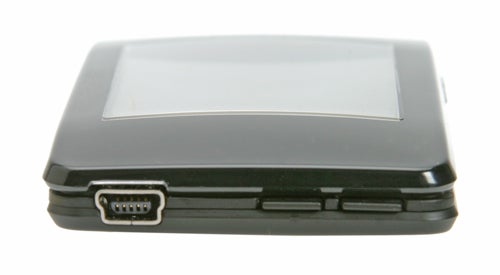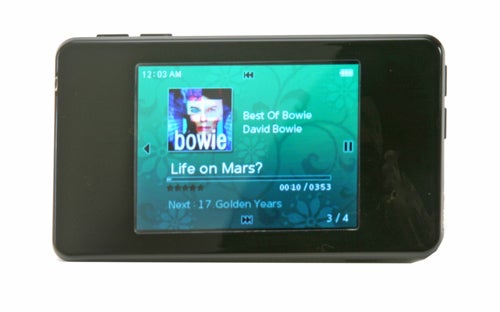iRiver clix 2 4GB MP3/Media Player Review
iRiver clix 2 4GB MP3/Media Player
Has iRiver produced the most desirable MP3 player out there? Riyad certainly thinks so.

Verdict
Key Specifications
- Review Price: £139.00
In my experience iRiver products never quite hit the mark. Despite the fact that iRiver players tend to exhibit superior sound quality to pretty much anything else on the market (bar Sony), the clumsy design and poor user interface tend to overshadow those aural delights. But this time iRiver seems to have got almost everything right and the clix 2 is possibly the most desirable portable media player available.
The clix represents the evolution of the iRiver U10 that Benny reviewed over a year ago. Although the U10 was an innovative and feature rich player, it was hugely overpriced and lacked the design chic that oozes from the core of Apple products. I’m not sure who iRiver employed to design the clix, but whoever it was deserves a big promotion – the clix really does look THAT good.
Unlike most small MP3/media players, the clix is designed to be used in a landscape orientation, although you can switch it round to portrait if you prefer. The reason that the landscape orientation works so well is that there are no buttons or switches on the fascia to spoil the clean lines. In fact, the clix looks like a very small TV, and I think that’s exactly the look that iRiver was going for. 
There’s a 2.2in screen at the centre of the clix with a resolution of 320 x 240. But this isn’t just any screen, iRiver has equipped the clix with an AMOLED or Active Matrix Organic LED screen. While many players use small OLED screens due to the low power they draw and the emissive nature of the technology, an Active Matrix OLED screen applies a thin film transistor (TFT) sheet. The TFT aspect of the screen allows each pixel to be charged separately with an independent degree of brightness, the transistors also allow for very fast switching, making this screen far more suited to viewing video than a standard Passive Matrix OLED display.
Leaving the intrinsic technology behind the screen to one side, there is only one really important thing that you need to know, it looks absolutely fantastic! The screen is unbelievably bright, the colours strikingly vivid and the viewing angle close to infinite. Viewing pictures on the clix is an absolute joy, but even more impressive is how good a job it does of playing back video. I’d always considered watching video on a device this size as being a marketing gimmick, but on the clix it’s actually an enjoyable experience. I’m not sure if it’s the landscape aspect ratio of the device, or the fact that the front of the player is devoid of buttons or labels, but there’s something about the clix that makes it a viable pocket sized movie machine. And when you’re watching video, that Active Matrix OLED really does show its colours – literally! The images are bright, vibrant and amazingly clear, no matter how much action is going on.
With absolutely no buttons or controls on the fascia, you’re probably wondering how you control the clix. The obvious answer would be squeezing buttons onto the edges, and in reality there are a few of those, but none of them are used for navigation. To navigate through the menus and generally use the clix you actually press the edges of the fascia – this gives you four-way navigation without the need for a dedicated control taking up space on the front of the device. So simple is this navigation method that I’m amazed that no other manufacturers are using it, especially since it would allow the creation of a player where the entire front fascia is the screen. Of course there is the issue of fingerprints on the screen, but pretty much every player is subject to that greasy problem.
There are four buttons located around the edges of the device, two of which control the volume, one is the power button and the last can be programmed to do anything from starting a recording, to jumping back to the home screen. There’s also a hold switch, which is very useful considering how easy it would be to inadvertently click the fascia. There’s a standard 3.5mm headphone jack on the left side and a mini-USB port on the right. It’s great to see that iRiver has gone for standard mini-USB rather than a proprietary connection, meaning that you can use any USB to mini-USB cable. There is also a setting in the Advanced menu that allows you to change the USB mode – you can have either Power & Data or Power & Play. This means that if you just want to charge the player when connected to your PC, you can still play your music – Apple and SanDisk please take note!
So, the clix looks superb, has killer navigation and the best screen I’ve ever seen on such a small and slim player. Talking of small and slim, the clix measures only 80 x 46 x 12mm (WxHxD) and weighs in at a feather light 55g. But has iRiver compromised on sound quality in its quest for stylish and sleek design? Absolutely not!
I plugged my Shure E500PTH earphones into the clix to make the most of the sound being pumped out and I wasn’t disappointed. Cueing up Blues Grinder by Ronny Jordan instantly demonstrated that iRiver hasn’t just maintained its reputation for great sound quality, it has built on it. Ronny’s licks have never sounded so good – if I closed my eyes I could almost picture the inside of Ronnie Scott’s in Soho or the Iridium Club in Manhattan, with the incomparable Mr Jordon up on stage. Even when the guitar solo takes over proceedings, the bass line still thumps through your ears, but doesn’t overpower Ronny’s efforts. And all the while that snare drum cuts through your brain keeping the beat with the precision of a Swiss chronometer.
Moving closer to the middle of the road, I turned to the Goo Goo Dolls and Iris. Again the clix produced a very strong sound stage, with a level of clarity and cohesion that I rarely experience when listening to an MP3 encode. The acoustic guitars are beautifully rendered, while the strings section that springs to life during the climax is easily discernable and flows over the vocals, just the way it should.
Of course it could be argued that any player will sound good with a set of Shure E500s plugged into it, but that’s not actually the case. In reality these earphones often highlight the inadequacies of a player, but the clix definitely seemed to complement the E500s, especially when sticking to high bit rate encodes. Also in its favour is the fact that the clix supports OGG, which is a far superior codec to MP3, although even I tend to keep most of my collection in MP3, since I know I can then play it on any device – I do rip everything at 320kbit though!
The clix also has a built-in FM tuner, which worked surprisingly well. I often find that integrated tuners are a bit hit and miss, but I managed to lock onto pretty much all the radio stations that I expected to find, while the sound quality was first rate, even when walking around. You can also record directly from the radio if you wish, while an integrated microphone also allows you to use the clix as a Dictaphone, something that’s always handy in my line of work. 
Getting your music onto the clix couldn’t be easier. Instead of having to install a music manager like iTunes or SonicStage, you can simply drag and drop all your tracks to the device. Not only does this make things quick and easy, it also means that you can drag your music off the clix – ideal if you wanted to dump some music onto your work computer that you’d ripped at home. This drag and drop behaviour was one of the reasons that we liked the SanDisk Sansa e260 so much, but the clix pulls this trick off with even more style. Any Sansa e260 user will tell you that one of the annoyances of the player is that it takes an age to startup, this is because it has to rebuild its music library each time it’s powered on in case you’re dropped some new songs on it. The clix powers on instantaneously, because it doesn’t rebuild the library on each startup – what this does mean is that you need to manually click the “rebuild library” selection whenever you do add music, but that’s definitely preferable to having to wait every time you power on.
iRiver quotes a playtime of 24 hours for music, which doesn’t seem unreasonable – I took the clix with me on a Press trip to Tunisia last week, I was away for three days and used it on both flights and in the evenings without charging it once. Video playback time is quoted at five hours, which again isn’t bad, especially since you’re unlikely to want to watch that much video in one go anyway.
So, the iRiver clix is just about perfect right? Well, not quite. You see, one of the things that has made the iPod such a huge hit with consumers is the totally seamless integration between hardware and software. An iPod and iTunes just work perfectly together, and it’s easy for even a complete technophobe to figure out how to get music, video or podcasts onto their player. Unfortunately things aren’t quite so simple with the clix, because although getting your music onto the device is simply a drag and drop procedure, getting video onto it is a little more complicated.
You see the iRiverPlus 3 software that ships with the clix is far from intuitive, even for someone who knows their way around software and hardware. Upon loading the software there is absolutely no mention of video, and no obvious way of transcoding your movies into a format that the clix will recognise. I had already tried dragging and dropping video in multiple formats onto the clix, but it refused to play any of them. In a fit of desperation I fired up the software once more and then plugged the clix into a USB port. Low and behold a message popped up informing me that my player supported video, so I should restart the software upon which point there would be a video option included!
Once I had been given the option to transcode my video and port it to the clix I proceeded to convert a 45 minute TV show, and was once again surprised because it took over 45 minutes to convert the file. Considering that other software, like ATI’s Avivo utility can do a similar job in around five minutes, iRiver really needs to come up with a better solution than iRiverPlus 3.
This 4GB iRiver clix will set you back £139, which means it costs exactly £10 more than a 4GB iPod nano. Of course the latter doesn’t playback video, doesn’t have a screen anywhere near as good, doesn’t sound as good, doesn’t allow you to drag and drop, doesn’t use a standard mini-USB connection and most surprising of all, doesn’t look as good! The 4GB version of Sony’s latest Network Walkman costs almost the same as the clix, but having compared the two devices, even Sony’s player is slightly overshadowed by this iRiver – although the sound quality is on a par. Of course like the iPod, the Sony won’t let you drag and drop music. ![]()
That leaves the SanDisk Sansa e260 and here there really is a significant price difference. The 4GB Sansa costs as little as £79.99 these days, which really does represent amazing value for money. But it has to be said that the Sansa is considerably larger and heavier than the clix, while it also can’t match this iRiver in the sound quality stakes. Ultimately if I could choose between all the current slim and light players available right now, I think that the iRiver clix would be at the top of my list.
”’Verdict”’
iRiver has produced a superb portable music/media player in the shape of the clix 2. It’s beautifully styled, easy to use, has a truly stunning screen and incredible sound quality. The clix is very well featured, while the ability to drag and drop music and the use of a standard mini-USB connection will please a great many consumers.
If there’s one thing that lets the clix down it’s the bundled software. While the hardware is intuitive and easy to get to grips with, the iRiverPlus 3 software is obtuse and near impossible to fathom – at least initially. But the substandard software can’t diminish the fact that the clix is now my favourite MP3 player, and I will be very, very sad when I have to return it.
Trusted Score
Score in detail
-
Value 8
-
Features 9

